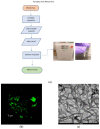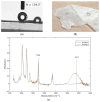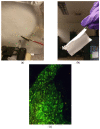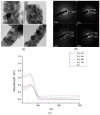Polymorphic Biological and Inorganic Functional Nanomaterials
- PMID: 35955287
- PMCID: PMC9369650
- DOI: 10.3390/ma15155355
Polymorphic Biological and Inorganic Functional Nanomaterials
Abstract
This perspective involves two types of functional nanomaterials, amyloid fibrils and metal oxide nanowires and nanogrids. Both the protein and the inorganic nanomaterials rely on their polymorphism to exhibit diverse properties that are important to sensing and catalysis. Several examples of novel functionalities are provided from biomarker sensing and filtration applications to smart scaffolds for energy and sustainability applications.
Keywords: amyloids; electrospinning; nanomaterials; polymorphism.
Conflict of interest statement
Authors declare no conflict of interest.
Figures










Similar articles
-
Inorganic Hydrogel Based on Low-Dimensional Nanomaterials.ACS Nano. 2024 Jan 30;18(4):2730-2749. doi: 10.1021/acsnano.3c11262. Epub 2024 Jan 14. ACS Nano. 2024. PMID: 38221737 Review.
-
Functional micro/nanostructures: simple synthesis and application in sensors, fuel cells, and gene delivery.Acc Chem Res. 2011 Jul 19;44(7):491-500. doi: 10.1021/ar200001m. Epub 2011 May 25. Acc Chem Res. 2011. PMID: 21612197
-
Nanomaterials: amyloids reflect their brighter side.Nano Rev. 2011;2. doi: 10.3402/nano.v2i0.6032. Epub 2011 May 31. Nano Rev. 2011. PMID: 22110868 Free PMC article.
-
Catalytically Active Amyloids as Future Bionanomaterials.Nanomaterials (Basel). 2022 Oct 28;12(21):3802. doi: 10.3390/nano12213802. Nanomaterials (Basel). 2022. PMID: 36364578 Free PMC article. Review.
-
Material Nanoarchitectonics of Functional Polymers and Inorganic Nanomaterials for Smart Supercapacitors.Small. 2022 Feb;18(7):e2102397. doi: 10.1002/smll.202102397. Epub 2021 Dec 3. Small. 2022. PMID: 34862722 Review.
References
-
- Schultz M. Rudolf Virchow. Emerg. Infect. Dis. 2008;14:1480. doi: 10.3201/eid1409.086672. - DOI
Grants and funding
LinkOut - more resources
Full Text Sources

